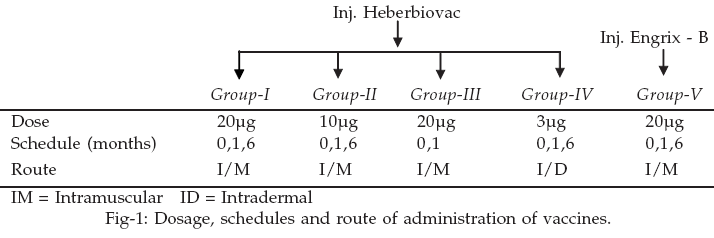1. Burroughs AK, Westaby D. Liver, biliary tract and
pancreatic disease. In: Kumar P, Clark M, editors. Clinical medicine. 6th ed.
UK: Bath Press, 2005;347-417.
2. Gust ID. Epidemiology of hepatitis B infection in the
Western pacific & South East Asia. GUT 1996;38(Suppl-2):18-23.
3. Khan AA, Rehman KU, Haider Z, Shafqat F. Seromarkers of
hepatitis B and C in patients with cirrhosis. J Coll Physicians Surg Pak
2002;12:105-7.
4. Rehman AU, Murad S. Hepatocellular carcinoma, a
retrospective analysis of 118 cases. J Coll Physicians Surg Pak 2002;12:108-9.
5. WHO. Control of viral hepatitis. Bull WHO
1987;65:407-11.
6. WHO. Requirements for hepatitis B recombinant DNA
techniques for biological substances. WHO Tech Rep Ser 1989;45.
7. CDC. Hepatitis B virus: a comprehensive strategy for
eliminating transmission in the united states through universal childhood
vaccination. Recommendations of the Advisory Committee on Immunisation
Practices (ACIP). MMWR 1991;40(No. RR -13):1-19.
8. Zajac BA, West DJ, McALeer WJ, Scolnick EM. Overview of
clinical studies with hepatitis B vaccine made by recombinant DNA. J Infect
1986;13(Suppl A):39-45.
9. Andre FE. Summary of safety and efficacy data on a yeast
derived hepatitis B vaccine. Am J Med 1989;87(Suppl 3A):14s-20s.
10. Szmuness W, Stevens CE, Harley EJ, Zang EA, Oleszko WR,
William DC, et al. Hepatitis B vaccine: Demonstration of efficacy in a
controlled clinical trial in a high risk population in the United States. N
Engl J Med 1980;303:833-41.
11. Coates T, Wilson R, Patrick G, Andre F, Watson V.
Hepatitis B vaccines: Assessment of the seroprotective efficacy of two
recombinant DNA vaccines. Clin Ther 2001;23:392-403.
12. Kar P, Jandwani P, Khurana V, Kumar V, Gupta RK, Sama
S, et al. Seroconversion with rDNA hepatitis B vaccine of Cuban origin. Indian
J Gastroenterol 1997;16(4):161.
13. Gonzales MD, Macia AC, Acosta DD, Gonzales BJ, Lay LR,
Flaquet PP, et al. The immunogenicity of the heberbiovac-HB vaccine in
children. Rev Cubana Med Trop 1996;48:195-8.
14. Jain A, Mathur US, Jandvani P, Gupta RK, Kumar V, Kar
P, et al. A multicentric evaluation of recominant DNA hepatitis B vaccine of
Cuban origin. Trop Gastroenterol 2000;21:14-7.
15. Froehlich H, West DJ. Comliance with hepatitis B virus
va-ccine in a high risk population. Ethin Dis 2001;11:548-53.
16. Sokhey J, Jain DC, Harit AK, Dhariwal AC. Moderate
immunization coverage levels in East Delhi: implications for disease control
programmes and introduction of new vaccines. J Trop Pediatr 2001;47:199-203.
17. Levaux HP, Schonfeld WH, Pellissier JM, Cassidy WM,
Sherrif SK, Fitzsimon C. Economic evaluation of a 2-dose hepatitis B
vaccination regimen for adolescents. Pediatrics 2001;108:317-25.
18. Cassidy WM, Watson B, Ioli VA, Wiiliams K, Bird S, West
DJ. A randomised trial of alternative two and three dose hepatitis B
vaccination regimens in adolescents: Antibody responces, safety immunogenic
memory. Pediatrics 2001;107:626-31.
19. Turshi MD, Martelli CM, Ferraz ML, Silva AE, Cardoso D,
Das D, et al. Immunogenicity of low dose intramuscular and intradermal
vaccination with recombinant hepatitis B vaccine. Rev Inst Med Trop
1997;39:15-9.
20. Yamasshki M, Kosaka Y, Nishimura A. An effective
intradermal hepatitis B vaccination. Vaccine 1997;15:1618-23.
21. Egemen A, Aksit S, Kurugol Z, Erensoy S, Bilgic A,
Akilli M. Low-dose intradermal versus intramuscular administration of
recombinant hepatitis B vaccine: a comparison of immunogenicity in infants an
pre school children. Vaccine 1998;16:1511-5.
22. Wagner RP, Kundi M, Stemberger H, Wiedermann G,
Holzmann H, Hofer M, et al. Antibody response to three recombinant hepatitis B
vaccines: comparative evaluation of multi center travel-clinic based
experience. Vaccine 2001;19:2055-60.
23. Roels LG, Abraham B, Fourneau M, DeClercq N, Safary A.
A comparision of two commercially prepared vaccines for hepatitis B in
adolescents. Vaccine 2000;19:937-42.
24. Hardy E, Martinez E, Diago D, Diaz R, Gonzalez D,
Herrera L. Large scale production of recombinant hepatitis B surface antigen
vaccine from Pichia pastoris. J Biotechnol 2000;77:157-67.
25. Diaz Gonzales M, Navia Molina O, Bravo Gonzalez JR,
Pedorso Flaquet P, Urbino Lopez A. The reactogenicity of Heberbiovac-HB
vaccine at different dosed. Rev Cubana Med Trop 1995;47(1):65-70.
26. Singh S, Sharma DR. Tolerability of a recombinant DNA
hepatitis B vaccine. Results of Post-marketing surveillance. J Commun Dis
1999;31(1):53-5.
27. Propst T, Propst A, Lhotta. Reinforced intradermal
hepatitis B vaccination in hemodialysis patients is superior in antibody
response to intramuscular or subcutaneous vaccination. Am J Kidney Dis
1998;32:1041.
28. Rahman F, Dahmen A, Herzog-Hauff. Cellular and humoral
immune responses induced by intradermal or intramuscular vaccination with the
major hepatitis B surface antigen. Hepatology 2000;31:521.
29. Rault R, Freed B, Nespor S, Bender F. Efficacy of
different hepatitis B vaccination strategies in patients receiving
hemodialysis. ASAIO J 1995;41:M717.
30. Fabrizi F, Andrulli S, Bacchini, G. Intradermal versus
intramuscular hepatitis B revaccination in non-responsive chronic dialysis
patients: A prospective randomized study with cost-effectiveness evaluation.
Nephrol Dial Transplant 1997;12:1204.
31. Fabrizi, F, Dixit, V, Magnini, M. Meta-analysis:
intradermal vs. intramuscular vaccination against hepatitis B virus in
patients with chronic kidney disease. Aliment Pharmacol Ther 2006;24:497.
32. Flaquet PP, Lay LR, Gonzalez MD. Immunogenicity of a
recombinant DNA yeast derived hepatitis B vaccine at different doses in
healthy young adults. Infect Dis Rev 2001;3:138-42.
33. Gonzalez-Griego MJ, Cinza Z, Ortega A. A comparative study between
different regimens for administering two doses of the Cuban anti-hepatitis B
vaccine. Rev Cubana Med Trop 1998;50(3):218-20.


